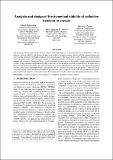Analysis and design of the dynamical stability of collective behavior in crowds
Author(s)
Mukovskiy, Albert; Giese, Martin A.; Slotine, Jean-Jacques E
DownloadAnalysis_and_Design_of_the_Dynamical_Stability_of_.pdf (2.392Mb)
OPEN_ACCESS_POLICY
Open Access Policy
Creative Commons Attribution-Noncommercial-Share Alike
Terms of use
Metadata
Show full item recordAbstract
The modeling of the dynamics of the collective behavior of multiple characters is a key problem in crowd animation. Collective behavior can be described by the solutions of large-scale nonlinear dynamical systems that describe the dynamical interaction of locomoting characters with highly nonlinear articulation dynamics. The design of the stability properties of such complex multi-component systems has been rarely studied in computer animation. We present an approach for the solution of this problem that is based on Contraction Theory, a novel framework for the analysis of the stability complex nonlinear dynamical systems. Using a learning-based realtime-capable architecture for the animation of crowds, we demonstrate the application of this novel approach for the stability design for the groups of characters that interact in various ways. The underlying dynamics specifies control rules for propagation speed and direction, and for the synchronization of the gait phases. Contraction theory is not only suitable for the derivation of conditions that guarantee global asymptotic stability, but also of minimal convergence rates. Such bounds permit to guarantee the temporal constraints for the order formation in self-organizing interactive crowds. Keywords: computer animation, crowd animation, coordination, distributed control, stability
Date issued
2011-01Department
Massachusetts Institute of Technology. Department of Mechanical EngineeringJournal
Journal of WSCG
Publisher
University of West Bohemia
Citation
Mukovskiy, Albert, Jean-Jacques E. Slotine, and Martin A. Giese. "Analysis and design of the dynamical stability of collective behavior in crowds." Journal of WSCG, 19.1, 2011: 69-76.
Version: Author's final manuscript
ISSN
1213-6972